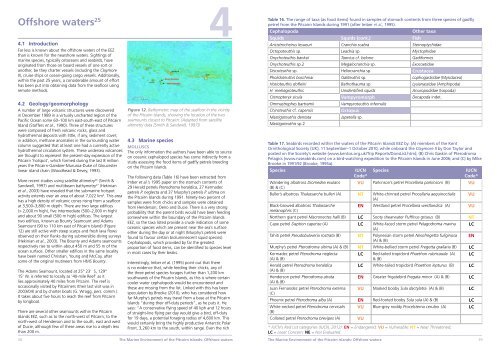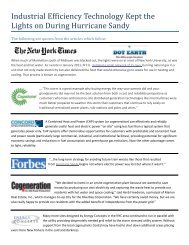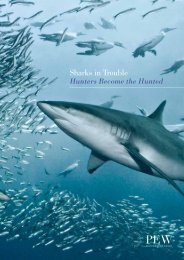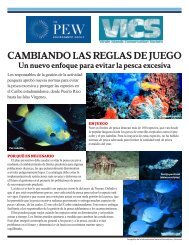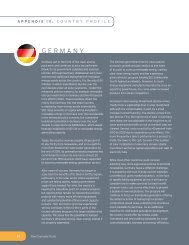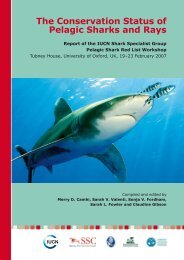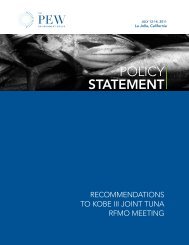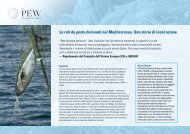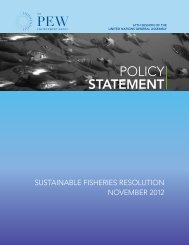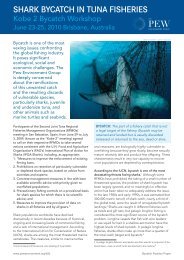The Marine Environment of the Pitcairn Islands - Pew Environment ...
The Marine Environment of the Pitcairn Islands - Pew Environment ...
The Marine Environment of the Pitcairn Islands - Pew Environment ...
You also want an ePaper? Increase the reach of your titles
YUMPU automatically turns print PDFs into web optimized ePapers that Google loves.
Offshore waters 25 4<br />
4.1 Introduction<br />
Far less is known about <strong>the</strong> <strong>of</strong>fshore waters <strong>of</strong> <strong>the</strong> EEZ<br />
than is known for <strong>the</strong> nearshore waters. Sightings <strong>of</strong><br />
marine species, typically cetaceans and seabirds, have<br />
originated from those on board vessels <strong>of</strong> one sort or<br />
ano<strong>the</strong>r, be <strong>the</strong>y charter vessels (including <strong>the</strong> Claymore<br />
II), cruise ships or ocean-going cargo vessels. Additionally,<br />
within <strong>the</strong> past 25 years, a considerable amount <strong>of</strong> effort<br />
has been put into obtaining data from <strong>the</strong> seafloor using<br />
remote methods.<br />
4.2 Geology/geomorphology<br />
A number <strong>of</strong> large volcanic structures were discovered<br />
in December 1989 in a virtually uncharted region <strong>of</strong> <strong>the</strong><br />
Pacific Ocean some 60–100 km east-south-east <strong>of</strong> <strong>Pitcairn</strong><br />
Island (St<strong>of</strong>fers et al., 1990). Three <strong>of</strong> <strong>the</strong>se structures<br />
were composed <strong>of</strong> fresh volcanic rocks, glass and<br />
hydro<strong>the</strong>rmal deposits with little, if any, sediment cover;<br />
in addition, methane anomalies in <strong>the</strong> surrounding water<br />
column suggested that at least one had a currently active<br />
hydro<strong>the</strong>rmal circulation system. <strong>The</strong>se undersea volcanoes<br />
are thought to represent <strong>the</strong> present-day expression <strong>of</strong> <strong>the</strong><br />
<strong>Pitcairn</strong> ‘hotspot’, which formed during <strong>the</strong> last 8 million<br />
years <strong>the</strong> <strong>Pitcairn</strong>-Gambier-Mururoa-Duke <strong>of</strong> Gloucester<br />
linear island chain (Woodhead & Devey, 1993).<br />
More recent studies using satellite altimetry 26 (Smith &<br />
Sandwell, 1997) and multibeam bathymetry 27 (Hekinian<br />
et al., 2003) have revealed that <strong>the</strong> submarine hotspot<br />
activity extends over an area <strong>of</strong> about 7,022 km 2 . This area<br />
has a high density <strong>of</strong> volcanic cones rising from a seafloor<br />
at 3,500–3,800 m depth. <strong>The</strong>re are two large edifices<br />
(> 2,000 m high), five intermediate (500–2,000 m high)<br />
and about 90 small (500 m high) edifices. <strong>The</strong> largest<br />
two edifices, known as Bounty Seamount and Adams<br />
Seamount (90 to 110 km east <strong>of</strong> <strong>Pitcairn</strong> Island) (Figure<br />
12) are still active with steep scarps and fresh lava flows<br />
observed on <strong>the</strong>ir flanks during submersible diving surveys<br />
(Hekinian et al., 2003). <strong>The</strong> Bounty and Adams seamounts<br />
respectively rise to within about 450 m and 55 m <strong>of</strong> <strong>the</strong><br />
ocean surface. O<strong>the</strong>r smaller edifices in <strong>the</strong> same locality<br />
have been named Christian, Young and McCoy, after<br />
some <strong>of</strong> <strong>the</strong> original mutineers from HMS Bounty.<br />
<strong>The</strong> Adams Seamount, located at 25° 23’ S, 129°<br />
15’ W, is referred to locally as ’40-mile Reef’ as it<br />
lies approximately 40 miles from <strong>Pitcairn</strong>. <strong>The</strong> reef is<br />
occasionally visited by <strong>Pitcairn</strong>ers (<strong>the</strong>ir last visit was in<br />
2003/04) and by charter boats (G. Wragg, pers. comm.).<br />
It takes about five hours to reach <strong>the</strong> reef from <strong>Pitcairn</strong><br />
by longboat.<br />
<strong>The</strong>re are several o<strong>the</strong>r seamounts within <strong>the</strong> <strong>Pitcairn</strong><br />
<strong>Islands</strong> EEZ, such as to <strong>the</strong> north-west <strong>of</strong> <strong>Pitcairn</strong>, to <strong>the</strong><br />
north-west <strong>of</strong> Henderson and to <strong>the</strong> south, east and west<br />
<strong>of</strong> Ducie, although few <strong>of</strong> <strong>the</strong>se areas rise to a depth less<br />
than 200 m.<br />
Figure 12. Bathymetric map <strong>of</strong> <strong>the</strong> seafloor in <strong>the</strong> vicinity<br />
<strong>of</strong> <strong>the</strong> <strong>Pitcairn</strong> <strong>Islands</strong>, showing <strong>the</strong> location <strong>of</strong> <strong>the</strong> two<br />
seamounts closest to <strong>Pitcairn</strong>. (Adapted from satellite<br />
altimetry data [Smith & Sandwell, 1997])<br />
4.3 <strong>Marine</strong> species<br />
MOLLUSCS<br />
<strong>The</strong> only information <strong>the</strong> authors have been able to source<br />
on oceanic cephalopod species has come indirectly from a<br />
study assessing <strong>the</strong> food items <strong>of</strong> gadfly petrels breeding<br />
on <strong>the</strong> <strong>Pitcairn</strong> <strong>Islands</strong>.<br />
<strong>The</strong> following data (Table 16) have been extracted from<br />
Imber et al.’s 1995 paper on <strong>the</strong> stomach contents <strong>of</strong><br />
29 Herald petrels Pterodroma heraldica, 27 Kermadec<br />
petrels P. neglecta and 37 Murphy’s petrels P. ultima on<br />
<strong>the</strong> <strong>Pitcairn</strong> <strong>Islands</strong> during 1991. Ninety-two percent <strong>of</strong><br />
samples were from chicks and samples were obtained<br />
from Henderson, Oeno and Ducie. <strong>The</strong>re is a very strong<br />
probability that <strong>the</strong> parent birds would have been feeding<br />
somewhere within <strong>the</strong> boundary <strong>of</strong> <strong>the</strong> <strong>Pitcairn</strong> <strong>Islands</strong><br />
EEZ, so <strong>the</strong> taxa listed provide a crude indication <strong>of</strong> some<br />
oceanic species which are present near <strong>the</strong> sea’s surface<br />
ei<strong>the</strong>r during <strong>the</strong> day or at night (Murphy’s petrels were<br />
found to favour certain bioluminescent squid species).<br />
Cephalopods, which provided by far <strong>the</strong> greatest<br />
proportion <strong>of</strong> food items, can be identified to species level<br />
in most cases by <strong>the</strong>ir beaks.<br />
Interestingly, Imber et al. (1995) point out that <strong>the</strong>re<br />
is no evidence that, while feeding <strong>the</strong>ir chicks, any <strong>of</strong><br />
<strong>the</strong> three petrel species forages fur<strong>the</strong>r than 1,200 km<br />
southwards <strong>of</strong> <strong>the</strong> <strong>Pitcairn</strong> <strong>Islands</strong>, as this is where certain<br />
cooler water cephalopods would be encountered and<br />
<strong>the</strong>se are missing from <strong>the</strong> list. Linked with this has been<br />
speculation by Brooke (2010), who has considered how<br />
far Murphy’s petrels may travel from a base at <strong>the</strong> <strong>Pitcairn</strong><br />
<strong>Islands</strong> “during <strong>the</strong>ir <strong>of</strong>f-duty periods”, as he puts it. He<br />
says: “A conservative flying speed <strong>of</strong> 40 kph and 12 hours<br />
<strong>of</strong> straight-line flying per day would give a bird, <strong>of</strong>f-duty<br />
for 19 days, a potential foraging radius <strong>of</strong> 4,600 km. This<br />
would certainly bring <strong>the</strong> highly productive Antarctic Polar<br />
Front, 3,260 km to <strong>the</strong> south, within range. Even <strong>the</strong> rich<br />
Table 16. <strong>The</strong> range <strong>of</strong> taxa (as food items) found in samples <strong>of</strong> stomach contents from three species <strong>of</strong> gadfly<br />
petrel from <strong>the</strong> <strong>Pitcairn</strong> <strong>Islands</strong> during 1991 (after Imber et al., 1995).<br />
Cephalopoda O<strong>the</strong>r taxa<br />
Squids Squids (cont.) Fish<br />
Ancistrocheirus lesueuri Cranchia scabra Sternoptychidae<br />
Octopoteuthis sp. Leachia sp. Myctophidae<br />
Onychoteuthis banksii Taonius cf. belone Gadiformes<br />
Onychoteuthis sp.2 Megalocranchia sp. Exocoetidae<br />
Discoteuthis sp. Heliocranchia sp. Crustacea<br />
Pholidoteuthis boschmai Galiteuthis sp. Lophogastridae (Mysidacea)<br />
Histioteuthis d<strong>of</strong>leini Bathothauma sp. Lysianassidae (Amphipoda)<br />
H. meleagroteuthis Unidentified squids Anuropodidae (Isopoda)<br />
Ctenopteryx sicula Vampyromorph Decapoda indet.<br />
Ommastrephes bartramii Vampyroteuthis infernalis<br />
Chiroteuthis cf. capensis Octopus<br />
Mastigoteuthis dentata<br />
Mastigoteuthis sp.2<br />
Japetella sp.<br />
Table 17. Seabirds recorded within <strong>the</strong> waters <strong>of</strong> <strong>the</strong> <strong>Pitcairn</strong> <strong>Islands</strong> EEZ by: (A) members <strong>of</strong> <strong>the</strong> Kent<br />
Ornithological Society (UK), 11 September–1 October 2010, while onboard <strong>the</strong> Claymore II by Don Taylor and<br />
posted on <strong>the</strong> Society’s website (www.kentos.org.uk/Trip Reports/DonsList.htm); (B) Chris Gaskin <strong>of</strong> Pterodroma<br />
Pelagics (www.nzseabirds.com) on a bird-watching expedition to <strong>the</strong> <strong>Pitcairn</strong> <strong>Islands</strong> in June 2006; and (C) by Mike<br />
Brooke in 1991/92 (Brooke, 1995a).<br />
Species IUCN<br />
Code*<br />
Wandering albatross Diomedea exulans<br />
(B) & (C)<br />
38 <strong>The</strong> <strong>Marine</strong> <strong>Environment</strong> <strong>of</strong> <strong>the</strong> <strong>Pitcairn</strong> <strong>Islands</strong>: Offshore waters<br />
<strong>The</strong> <strong>Marine</strong> <strong>Environment</strong> <strong>of</strong> <strong>the</strong> <strong>Pitcairn</strong> <strong>Islands</strong>: Offshore waters<br />
Species IUCN<br />
Code*<br />
VU Parkinson’s petrel Procellaria parkinsoni (B) VU<br />
Buller’s albatross Thalassarche bulleri (A) NT White-chinned petrel Procellaria aequinoctialis<br />
(A)<br />
VU<br />
Black-browed albatross Thalassarche<br />
melanophris (C)<br />
EN Westland petrel Procellaria westlandica (A) VU<br />
Nor<strong>the</strong>rn giant petrel Macronectes halli (B) LC Sooty shearwater Puffinus griseus (B) NT<br />
Cape petrel Daption capense (A) LC White-faced storm petrel Pelagodroma marina<br />
(A)<br />
LC<br />
Tahiti petrel Pseudobulweria rostrata (B) NT Polynesian storm petrel Nes<strong>of</strong>regetta fuliginosa<br />
(A) & (B)<br />
EN<br />
Murphy’s petrel Pterodroma ultima (A) & (B) NT White-bellied storm petrel Fregetta grallaria (B) LC<br />
Kermadec petrel Pterodroma neglecta<br />
(A) & (B)<br />
Herald petrel Pterodroma heraldica<br />
(A) & (B)<br />
Henderson petrel Pterodroma atrata<br />
(A) & (B)<br />
Juan Fernandez petrel Pterodroma externa<br />
(C)<br />
LC Red-tailed tropicbird Phaethon rubricauda (A)<br />
& (B)<br />
LC<br />
LC White-tailed tropicbird Phaethon lepturus (B) LC<br />
EN Greater frigatebird Fregata minor (A) & (B) LC<br />
VU Masked booby Sula dactylatra (A) & (B) LC<br />
Phoenix petrel Pterodroma alba (A) EN Red-footed booby Sula sula (A) & (B) LC<br />
White-necked petrel Pterodroma cervicalis<br />
(B)<br />
VU Blue-grey noddy Procelsterna cerulea (A) LC<br />
Collared petrel Pterodroma brevipes (A) VU<br />
* IUCN’s Red List categories (IUCN, 2012): EN = Endangered; VU = Vulnerable; NT = Near Threatened;<br />
LC = Least Concern; NE = Not Evaluated.<br />
39


